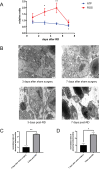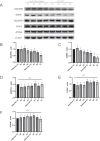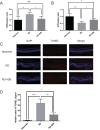Idebenone Protects Photoreceptors Impaired by Oxidative Phosphorylation Disorder in Retinal Detachment
- PMID: 39774627
- PMCID: PMC11721677
- DOI: 10.1167/iovs.66.1.17
Idebenone Protects Photoreceptors Impaired by Oxidative Phosphorylation Disorder in Retinal Detachment
Abstract
Purpose: Oxidative phosphorylation (OXPHOS) is an aerobic metabolic mechanism, and its dysfunction plays an important role in the pathological changes of ischemic diseases. However, systematic studies on the occurrence of retinal detachment (RD) are lacking.
Methods: Single-cell RNA sequencing (scRNA-seq) of the human retina was performed to detect the metabolic changes of various retinal cells after RD. In this study, animal experiments were conducted to explore the OXPHOS activity after RD. In addition, idebenone, a coenzyme Q10 (CoQ10) analog currently used to treat Leber hereditary optic neuropathy (LHON), was used to improve the OXPHOS disorder in experimental RD model.
Results: ScRNA-seq revealed abnormal energy metabolism and OXPHOS pathways in retinal cells after RD. Adenosine triphosphate (ATP) and reactive oxygen species (ROS) are the main products of OXPHOS, the mouse RD model indicated that the rise in ROS levels may have a greater impact on photoreceptors in the early stage, whereas decreased ATP synthesis was observed in the later stage; these changes threaten the function and morphology of the retina. Idebenone was administered to model mice intragastrically, leading to reduced ROS levels in the early stage post-RD and improved ATP synthesis in the later stage, which was closely related to the maintenance of mitochondrial morphology.
Conclusions: OXPHOS disorder leads to photoreceptor degeneration after RD, which can be alleviated by improving OXPHOS function.
Conflict of interest statement
Disclosure:
Figures




References
-
- Govers BM, van Huet RAC, Roosing S, et al. .. The genetics and disease mechanisms of rhegmatogenous retinal detachment. Prog Retin Eye Res. 2023; 97: 101158. - PubMed
-
- Melo IM, Zhou TE, Nagel F, et al. .. Histological changes in retinal detachment: a systematic review for the clinician. Surv Ophthalmol. 2024; 69: 85–92. - PubMed
-
- Yan Y, Wang Y, Ding J, Lu L, Ke GJ, Dong K.. TRPML1 inhibited photoreceptor apoptosis and protected the retina by activation of autophagy in experimental retinal detachment. Ophthalmic Res. 2021; 64: 587–594. - PubMed
MeSH terms
Substances
LinkOut - more resources
Full Text Sources
Medical
Miscellaneous

